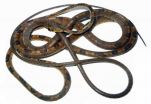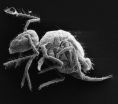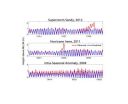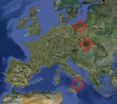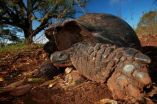(Press-News.org) Field and laboratory work by a group of zoologists led by Omar Torres-Carvajal from Museo de Zoología QCAZ, Pontificia Universidad Católica del Ecuador, has resulted in the discovery of a new species of blunt-headed vine snake from the Chocoan forests in northwestern Ecuador. This region is part of the 274,597 km2 Tumbes-Chocó-Magdalena hotspot that lies west of the Andes. The study was published in the open access journal ZooKeys.
Blunt-headed vine snakes live in an area comprising Mexico and Argentina, and are different from all other New World snakes in having a very thin body, disproportionately slender neck, big eyes, and a blunt head. They live in trees and hunt frogs and lizards at night. The new species described by Torres-Carvajal and his collaborators was named Imantodes chocoensis and increases the number of species in this group of snakes to seven.
Snakes collected as far back as 1994 and deposited in several Ecuadorian and American natural history museums were also examined. The authors were soon surprised with an interesting discovery. Some individuals from the Ecuadorian Chocó lacked a big scale on their face that is present in all other blunt-headed vine snakes from the New World. Other features, as well as DNA evidence, indicate that these Chocoan snakes actually belong to a new species. DNA data also suggest that its closest relative is a species that inhabits the Amazon on the other side of the Andes.
'One possible explanation for the disjunct distribution between the new species and its closest relative is that the uplift of the Andes fragmented an ancestral population into two, each of which evolved into a different species, one in the Chocó region and the other in the Amazon' said Dr Torres-Carvajal.
INFORMATION:
Original source
Torres-Carvajal O, Yánez-Muñoz MH, Quirola D, Smith EN, Almendáriz A (2012) A new species of blunt-headed vine snake (Colubridae, Imantodes) from the Chocó region of Ecuador. ZooKeys 244: 91. doi: 10.3897/zookeys.244.3950
About ZooKeys
ZooKeys is a peer-reviewed, open-access journal launched to support free exchange of ideas and information in biodiversity science, issued by Pensoft Publishers. All papers published in ZooKeys can be freely copied, downloaded, printed and distributed at no charge for the reader. ZooKeys implemented several cutting-edge innovation in publishing and dissemination of science information and is considered a technological leader in its field.
Additional Information
This research was funded by Secretaría Nacional de Educación Superior, Ciencia y Tecnología del Ecuador (SENESCYT) and Instituto Bioclon of Mexico.
Posted by Pensoft Publishers.
A rather thin and long new snake crawls out of one of Earth's biodiversity hotspots
2012-11-27
ELSE PRESS RELEASES FROM THIS DATE:
Three new arthropod species have been found in the Maestrazgo Caves in Teruel
2012-11-27
A team of scientists from the University of Navarra and the Catalan Association of Biospeleology have discovered three new collembolan species in the Maestrazgo caves in Teruel, Spain. Their description has been published in the Zootaxa journal. These minute animals belong to one of the most ancient animal species on the planet.
The Maestrazgo caves in Teruel are located in a region of the Iberian Range where fauna has not been the subject of much study. It is a very isolated region since its average altitude is between 1,550 m and 2,000 m asl and its climate can be described ...
New test to help heavy drinkers reduce alcohol intake
2012-11-27
Researchers at the University of Liverpool have developed a computer-based test that could help heavy drinkers reduce their alcohol consumption.
Regular heavy drinking can lead to serious health conditions such as liver and heart disease, costing the NHS millions of pounds every year. Research at Liverpool has shown that the habit of consuming alcohol can be interrupted when people practice methods of restraint whenever they see images of alcoholic drinks.
The team developed a computer test that required participants to press particular buttons when an image of alcohol ...
Paralysis by analysis should not delay decisions on climate change
2012-11-27
Uncertainty about how much the climate is changing is not a reason to delay preparing for the harmful impacts of climate change says Professor Jim Hall of the Environmental Change Institute at the University of Oxford and colleagues at the Tyndall Centre for Climate Change Research, writing today in Nature Climate Change.
The costs of adapting to climate change, sea-level and flooding include the upfront expenses of upgrading infrastructure, installing early-warning systems, and effective organisations, as well as the costs of reducing risk, such as not building on flood ...
Researcher studies 'middle ground' of sea-level change
2012-11-27
The effects of storm surge and sea-level rise have become topics of everyday conversation in the days and weeks following Hurricane Sandy's catastrophic landfall along the mid-Atlantic coast.
Ongoing research by professor John Brubaker of the Virginia Institute of Marine Science is throwing light on another, less-familiar component of sea-level variability—the "intra-seasonal" changes that occupy the middle ground between rapid, storm-related surges in sea level and the long-term increase in sea level due to global climate change.
"These are cases when the water is ...
From Mediterranean coasts to Tatra Mountains and beyond: Plant chromosome number variation
2012-11-27
Chromosome number is the most basic feature concerning the genome of a species, and it is known for about one third of higher plant species. In particular, for plants of Italy, Slovakia, and Poland, online chromosome number databases have been developed: 'Chrobase.it – Chromosome numbers for the Italian flora', 'Karyological database of ferns and flowering plants of Slovakia' and 'Chromosome number database – PLANTS', respectively. The three datasets account for about 35%, 60% and 40% of the whole floras, respectively.
"We used these datasets to compare chromosome number ...
Researchers explore social media as preventative method for infectious diseases
2012-11-27
MANHATTAN, Kan. -- When it comes to stopping illness, social media posts and tweets may be just what the doctor ordered.
A Kansas State University-led research team is looking at social media as a tool to reduce and prevent diseases from spreading. Researchers are studying whether a well-timed post from a public authority or trustworthy person could be as beneficial as flu shots, hand-washing or sneezing into an elbow.
"Infectious diseases are a serious problem and historically have been a major cause of death," said Faryad Sahneh, Kansas State University doctoral candidate ...
Man's best friend: Common canine virus may lead to new vaccines for deadly human diseases
2012-11-27
Athens, Ga. – Researchers at the University of Georgia have discovered that a virus commonly found in dogs may serve as the foundation for the next great breakthrough in human vaccine development.
Although harmless in humans, parainfluenza virus 5, or PIV5, is thought to contribute to upper respiratory infections in dogs, and it is a common target for canine vaccines designed to prevent kennel cough. In a paper published recently in PLOS ONE, researchers describe how this virus could be used in humans to protect against diseases that have eluded vaccine efforts for decades.
"We ...
Galapagos tortoises are a migrating species
2012-11-27
This press release is available in German.
The Galapagos giant tortoise, one of the most fascinating species of the Galapagos archipelago, treks slowly and untiringly across the volcanic slopes. Scientists of the Max Planck Institute for Ornithology in Radolfzell, together with the Charles Darwin Foundation, have used GPS technology and modern 3D acceleration measurements to find out that especially the dominant male tortoise wanders up to 10 kilometres into the highlands of the island. Only the fully grown animals migrate, the young tortoises stay year round in ...
Do missing Jupiters mean massive comet belts?
2012-11-27
Using ESA's Herschel space observatory, astronomers have discovered vast comet belts surrounding two nearby planetary systems known to host only Earth-to-Neptune-mass worlds. The comet reservoirs could have delivered life-giving oceans to the innermost planets.
In a previous Herschel study, scientists found that the dusty belt surrounding nearby star Fomalhaut must be maintained by collisions between comets.
In the new Herschel study, two more nearby planetary systems – GJ 581 and 61 Vir – have been found to host vast amounts of cometary debris.
Herschel detected ...
Researchers study cry acoustics to determine risk for autism
2012-11-27
Autism is a poorly understood family of related conditions. People with autism generally lack normal social interaction skills and engage in a variety of unusual and often characteristic behaviors, such as repetitive movements. While there is no specific medical treatment for autism, some success has been shown with early behavioral intervention.
Understanding the importance of early diagnosis, researchers at Women & Infants' Brown Center for the Study of Children at Risk in collaboration with researchers at University of Pittsburgh have been studying the cry acoustics ...
